Astrophotography is one of those types of photography that when done right can produce some stunning photos. Just like any type of photography, understanding the scene and subject matter that you are photographing enables you to capture better images.
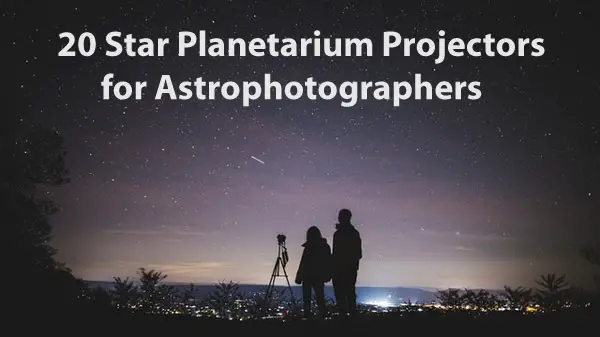
This is why more and more astrophotographers are turning to star planetarium projectors, as they allow you to learn the locations of the stars and the setup of the night sky before you’ve even taken your camera out of its bag.
Astrophotography is reliant on dark, clear skies. Depending on where you live, getting the right conditions may mean having to travel and/or wait for the weather to be on your side. If you then have to spend half the night trying to figure out where in the sky the thing that you are trying to photograph is, you could be missing out on great shots.
If you have access to a star planetarium projector you have access to the night sky whenever is convenient to you making learning the location of the stars a much quicker process. So which projector should you choose? Well, I’ve gathered together the best 20 that will help you up your astrophotography game to help easily find the right one for you.
A Short History of Planetarium Projectors
The dream of being able to accurately project the night sky inside a room is millennia old. Way back in 250 B.C. Archimedes developed the first device that showed the planetary motions. Over the years improvements by Ptolemy, the creation of the Gottorp Globe, then the Gororro Sphere and the Atwood Globe brought the dream closer.
At the beginning of the twentieth century the first device for projecting the planetary motions was developed. Known as the Orbitoscope and created by Professor E. Hindermann in Basel it comprised of two planets revolving around a central sun. One of the planets contained a small lightbulb which then cast a shadow across the other two objects.
However, it wasn’t until 1913 that the founder of the Deutsches Museum (German Museum) in Munich, Oskar von Miller, and astronomer and privy counsellor Max Wolf had an idea for a new kind of planetarium. They wanted to create an apparatus that would show the apparent motions of the sun, moon, planets, and stars.
In order to bring this idea to life they sought out the help of Carl Zeiss who owned a company that produced microscopes and other optical instruments. Following the conclusion of WW1 in March 1919, the chief design engineer for the Carl Zeiss Company (and later director) hit upon the idea of using a dark room and projecting the night sky using light.
Following several years of trials and development of mechanical devices in August 1923 an artificial sky was lit up inside for the very first time. The Model 1 (as it became known) was permanently installed within the German Museum in 1925.
As technology advanced through the years the Model 1 gave way to later models that became smaller in size. Then with the advent of computers, Carl Zeiss was able to add computer-assisted controlled systems to planetariums and incorporate fiber optics to depict the night sky in greater detail. This eventually led to the VELVET video projector in 2008 which was able to project the night sky in brilliant black as opposed to the gray of other projectors.
As planetariums became increasing computerized it was only a matter of time before “home planetariums” were developed. First released by Takayuki Ohira in cooperation with Sega, they are known for building portable planetariums that are often used in events and exhibitions as well as the Megastar projectors often seen in science museums and the Sega Toys Homestar.
Are Star Projectors for Adults?
While there are many night sky projectors that are designed to simply project stars onto a wall or ceiling to create a mood or to act as a night light for kids, they are not just for the amusement of children. There are also several different brands of planetarium projectors that can project detailed images of the night sky and are specifically made for adults. Whether you just want to track the movements of the stars or learn their locations for next time you’re on a shoot, star projectors are very much a gadget for the grown-ups.
Keep in mind that if you have a young photographer or little person interested in the stars at home, owning one of these projectors can be a great way to learn the sky together.
What to Look for In A Star Projector?
Not all-star projectors are made equal and while some are made simply as a kid’s toy to act more as a night light than anything else, others are able to give you far greater quality and actually allow you to learn the locations of stars.
How Big is The Star Projector?
Home Star projectors come in a variety of sizes. Knowing what kind of space constraints, you have (especially in terms of storage) is important to take into consideration before buying.
It’s also important to note that some of the projectors that are designed specifically for adults often have small pieces that can easily pull off. So even if the projector is for your grown-up self if there are kids around when you are using it you might need to keep an eye on them.
Does it Plug In?
While most star projectors can be plugged into the outlet there are also models that are powered by single use or rechargeable batteries. Those that are powered by rechargeable batteries usually come with a USB charging cable. However, these can be a little on the short side as they are intended solely for charging the projector when not in use.
Whatever kind of power system you go for will depend on where you plan to use the projector. If it’s just in the house where you’ll always have access to the outlets then great, go for a projector with a plug. If you’re a little more adventurous or perhaps plan to use it somewhere that there’s isn’t easy access to a plug socket, then a battery powered projector maybe a better option.

Don’t forget to check how long the battery should last though! A good star projector should run for about 10 hours on a full charge.
Can You Set A Timer?
Whether you are using the planetarium projector to learn the location of the stars or simply wanting to fall asleep under the stars from the comfort of your own bed while it rains outside, a timer means you can set the projector to automatically turn off after a certain amount of time. Who hasn’t woken up in the morning to realize that the bathroom light has been on all night? Well using the inbuilt timer stops that.
Most planetarium projectors come with a timer setting. Options can range from 15 minutes to several hours. This is great for if you want to test your star finding abilities by giving yourself a certain amount of time to locate stars or constellations before the projector turns off.
How Bright Is the Display?
The brighter the display the clearer and easier it is to figure out which stars and planets are located where and to distinguish one from another. Unfortunately, not all brands tell you this in their product specifications.
However, you can usually determine this by sleuthing through some of the online reviews. You can also consider the price of the particular planetarium projector. The cheaper models and those that are designed more to be toys or to set the rooms mood will likely offer lower quality displays than the higher end models.
Still Vs Rotating Displays
Star projectors with still displays project an image of the night sky that remains still. A projector with a rotating display, on the other hand, will project an image of the night sky that will move across the room and bounce across the ceiling and walls.
If your primary focus is to learn the night sky, then a model that allows you to switch between the two may be ideal. You can use the still display to learn the stars’ locations and then the rotating display to test yourself as you get better.
What Type of Display
Planetarium star projectors have been developed with a whole range of uses in mind. This means that not all projectors are ideal for astrophotographers. Some that are developed for kids even include aliens and spaceships flying through the sky and generally aren’t as detailed.
There are, however, many projectors that come with realistic images that allow you to see the planets, constellations, and star groups exactly as you would in the night sky and are more suitable for astrophotographers.
Can I Get Additional Discs?
Some projectors have the ability to interchange discs. These allow you to expand the range of celestial objects that can be displayed. Sometimes they come bundled with the projector and sometimes they need to be purchased separately.
These extra discs can allow you focus on certain areas of the night sky such as a particular planet, galaxy and even nebulae which can be great practice for capturing them when you get back outside under the actual night sky.
Does It Have A Remote Control?
A remote-control means added convenience. Sure, you can easily crouch down next to the projector and change the settings right there but when you get back up to admire the display it might not look exactly like you want it to. So back down to the projector you go.
A remote means that you can adjust the settings from wherever you want to view the projection from. While it isn’t essential, figuring out if a remote is something that would be useful before you buy is going to save you a lot of stress.
Best 20 Home Planetarium Projectors
Encalife Atmosphere Smart Galaxy Star Projector
This projector will be a winner if you’re big into Alexa and Google integrations. Simply connect to project to the Smart Life app to control it from anywhere using the app or your voice. The projector comes with 16.7 million nebula colors and adjustable motion speed.
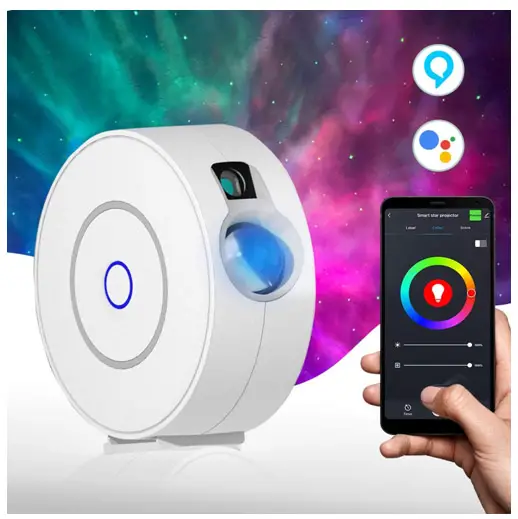
The projector is easily programed to switch on and off at specific times and fine tune the brightness of the star and nebula individually.
Pros:
- Alexa, Google & mobile app controlled.
- Programmable timer
- Adjustable light direction
- 7 million nebula cloud colors
Cons:
- Designed more for mood than stargazing.
Check the current price here
Encalife Ambience Star Projector
One of the few star projectors that comes with a remote, the Ambience Star Projector comes complete with adjustable brightness and a sleep timer.
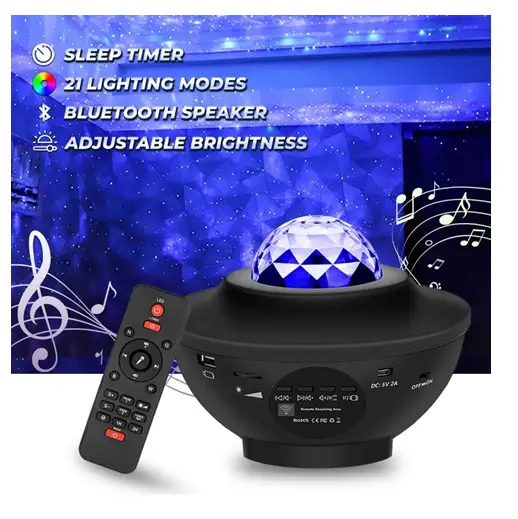
With 21 lighting modes and differing motion speeds you can visit a different galaxy every time.
Pros:
- Affordable
- Easy to use.
- Includes a remote
- Bluetooth connectivity
Cons:
- Designed for sleep, relaxation and mood setting rather than star gazing.
Check the current price here
Sega Homestar Classic
Sega Toys are the go-to brand for home planetariums. The Homestar Classic uses a disc-based system with different sky maps available to you. It comes with discs for the northern and southern hemispheres and additional discs including the Earth, Moon and Andromeda are available to buy separately.
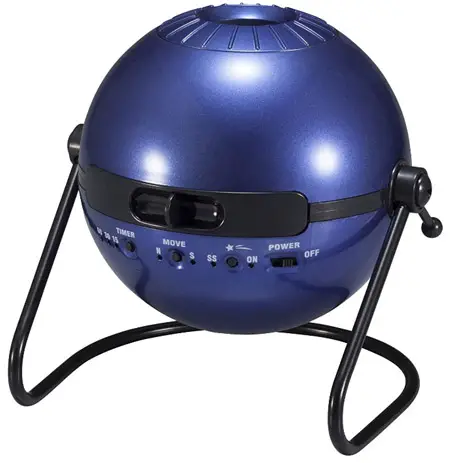
It comes with a 3-watt white LED projector and can project up to 60,000 stars. The projector itself weighs only 800g and its relatively small size means that it is easy to store when not in use.
Pros:
- Accurate representation of the night sky
- Timer option for 15, 30 and 60 minutes
- User friendly
- Includes ability to change focus and angle.
- Compact sturdy base keeps the projector in place.
Cons:
- It’s not as bright as some other projectors.
Check the current price here.
Sega Homestar Flux
The Homestar Flux is Segas most recent home planetarium projector. Boasting a 5-watt LED projector and 60,000 HD star display, the Flux recreates the night sky just like those deep in the countryside are used to seeing.
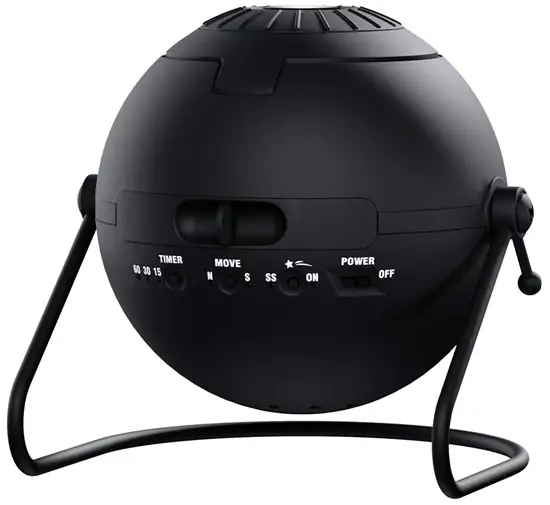
It comes with 2 discs, both of the northern hemisphere with and without the marked constellations. However, there are over 30 additional discs available to buy separately. Plus, a multitude of charging options with the included USB charging cable.
Like its predecessor the Flux has an auto-off timer for 15, 30 and 60 minutes as well as rotation and shooting star effect.
Pros:
- High Image Quality
- Versatile USB power cable
- Wide variety of extra discs
- Lightweight and compact
- Auto-off timer
Cons:
- On the expensive side
- Shooting Star effect appears in the same spot each time.
Check the current price here.
Omegon Star Theater Pro
A sleek looking device that projects realistic images of the night sky, the Star Theatre Pro is able to project up to 10,000 stars plus the Earth, Moon and Sun. It comes with a 3-watt LED projector and 2 discs. One disc shows a starry sky while the other is of the Earth, Moon and Sun.
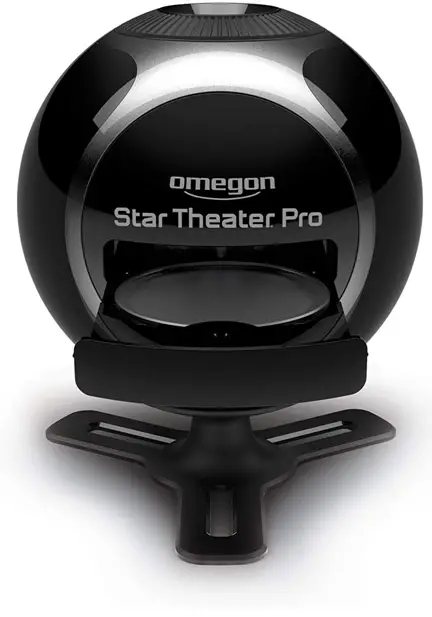
The projector is powered via a USB cable that can be plugged into a wall adapter or power bank and with just 4 buttons is simple to operate.
Pros:
- Easy to use.
- Powered via USB.
- Offers projection distance adjustment.
Cons:
- Projection is very detailed.
- No brightness adjustment
Check the current price here
Dark Skys DS-1 Star Projector
The Dark Skys DS-1 star projector has the ability to project over 4 million high-definition stars onto your wall or ceiling. It uses a chrome on glass star disc set up which is the only one in existence.
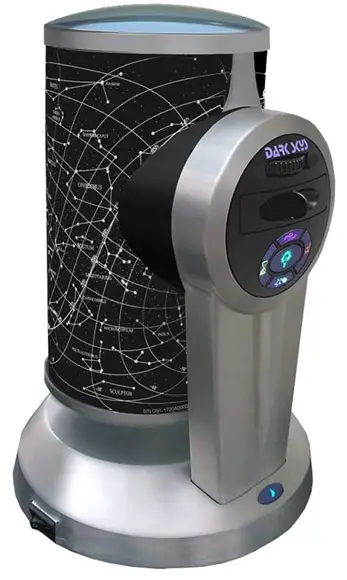
The projector comes with a northern hemisphere disc, but others are available to buy and offers 3 speed and reverse disc rotation. With a huge 10 watts of power and adjustable brightness you’ll feel like you can touch the stars.
Pros:
- Projects over 4 million stars
- Auto-off timer for 30, 60 minutes and 2 hours
- Can be rotated to project vertical or horizontal.
- The largest collection of star discs available
- Shooting star effect is random.
- includes a nightlight mode
- easy to use.
Cons:
- expensive
- Only available in the US
Check the current price here
Nashika Real Home Planetarium
Made by the Japanese brand Nasika this projector allows you to view the stars, Milky Way, constellations and even Earth. The projector is able to show you real-time viewing which means that you can see what the night sky looks like right now – a great advantage if you’re looking to learn the locations of stars for astrophotography!
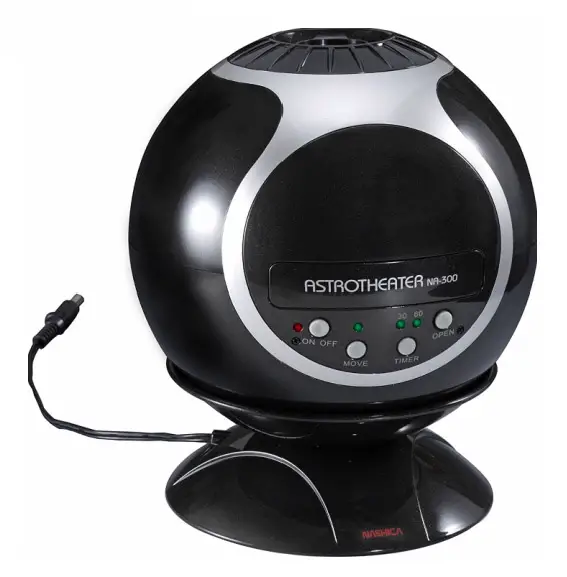
The images projected are noticeably clear and offers up to 9000 constellations and 31 galaxies with the 2 discs that are included. The only major downside is that the user manual is in Japanese which can make it a little challenging to first set up.
Pros:
- Projects up to 10,000 stars onto any flat surface
- Has an adjustable focus.
- Auto-off timer function
- USB charging cable
Cons:
- User Manual is in Japanese
- Fragile
Check the current price here
Ioptron Mini Livestar Planetarium
This home planetarium gives you lots of options, including being able to view the real-time night sky anywhere in the world. Its technology allows you to access a huge database with over 200 user-define objects.
It’s globe shape means that even when it’s not turned on it’ll still help you learn about the night sky.
Pros:
- Accurate display of stars, constellations, Milky Way
- Real-time night sky viewing
- Rotation function
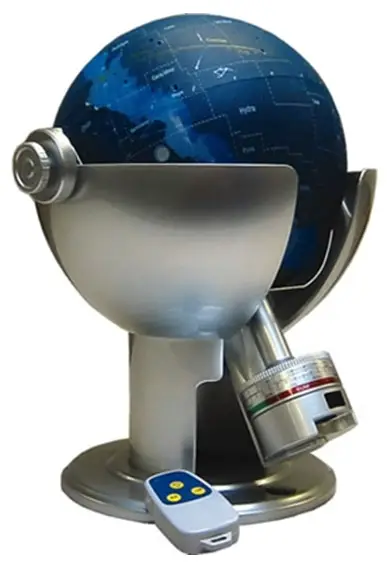
- Affordable
Cons:
- Not very durable
Check the current price here
Uncle Milton 3D Star Theatre
Want to feel like you’re actually standing in the stars? Then the 3D Star Theatre might just be what you’re after. Weighing just 1 pound and requiring 4 AAA batteries this home planetarium is very portable.
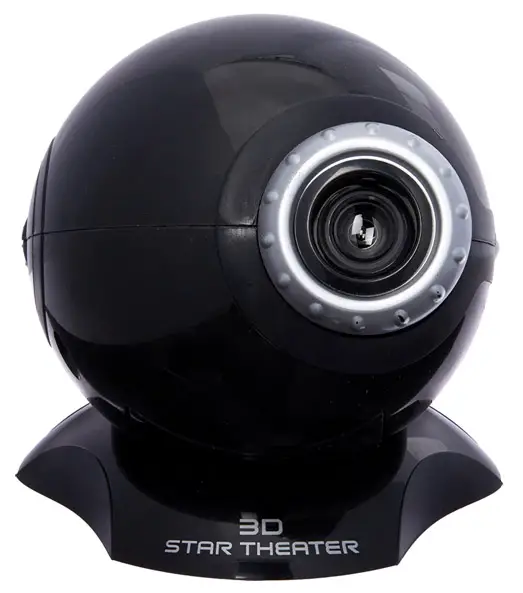
It comes complete with 3D glasses and a focus dial so that the stars are never blurry.
Pros:
- Affordable
- Easy to use.
- 3D images
Cons:
- Batteries not included.
Check the current price here
Sega Homestar Pure
The Homestar Pure is the mini, portable version in the Homestar planetarium series. Like the other Homestar projectors, it can project up to 10,000 stars but is battery powered for transportability.
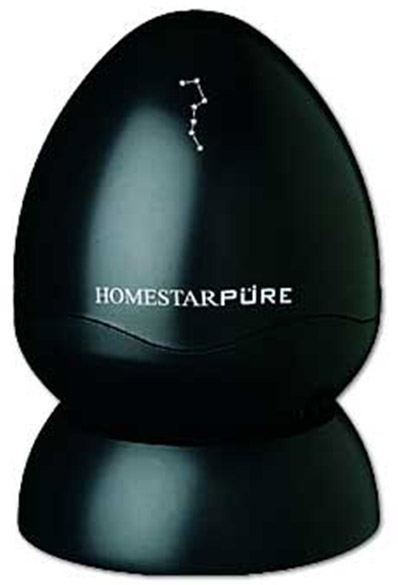
It also comes with two northern hemisphere star discs and a 30-minute timer function.
Pros:
- Portable
- 10,000 stars
- Auto-off timer
- Easy to use.
Cons:
- Manual is in Japanese.
Check the current price here
In My Room Star Theater Pro
This projector is very versatile with images that either rotate or remain still.
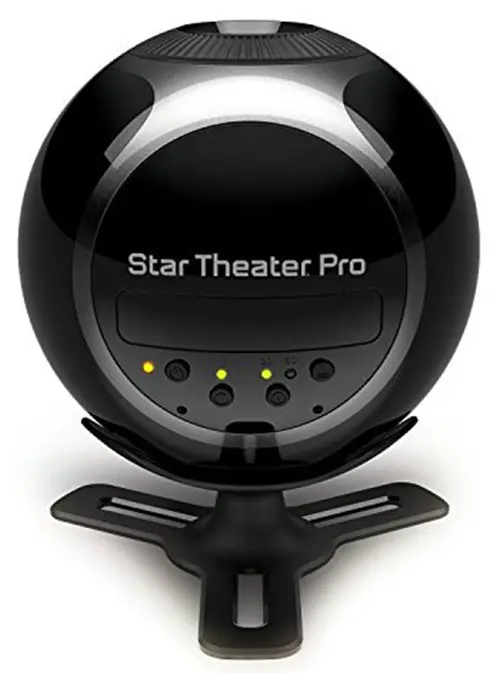
It has the ability to project stars, the Earth, moon, and sun using it’s ultra-bright LED source.
Pros:
- Adjustable focus and projection angle
- Auto-off timer
- Realistic night sky view
Cons:
- Discs have stopped being manufactured.
- Doesn’t include adapter.
Check the current price here
Smithsonian Optics Room Planetarium
Recreate the experience of the Smithsonian Air and Space Museum’s planetarium in your own home. Ok, so it’s never going to be able to truly replicate the experience, but this home planetarium star projector does a pretty good job.
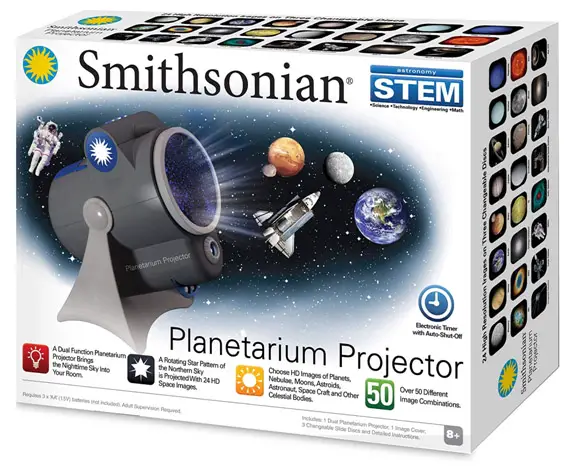
The projector comes with a rotating pattern of the northern hemisphere night sky plus multiple high-definition slides of the night sky. It runs on AA batteries which means you can use it wherever you want and has an auto-off function that turns the projector off after 15 minutes.
Pros:
- Easy to use.
- Have a choice of viewing the night sky, detailed images of planets and various celestial bodies.
- Can adjust projection angle.
- Works great with a large projection space
- Affordable
Cons:
- Not very bright
- Some images are blurry.
- Doesn’t feel high quality.
Check the current price here
Discovery Space and Planetarium Projector
This is a double-sided projector with stationary and rotating modes.
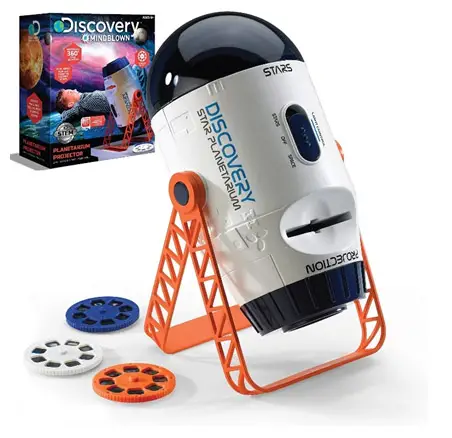
It comes with 4 discs with 8 slides each showing the nights sky, planets, and galaxies.
Pros:
- Affordable
- Easy to use.
- Design modeled on real space and observatory equipment.
- 30-minute auto-off timer
Cons:
- Images not very detailed
- Designed for kids.
- Battery powered.
Check the current price here
BlissLights Sky Lite
The BlissLights Sky Lite is super user friendly with just a 3-button control panel that allows you to cycle through the different settings. It has the ability to choose to see the stars, nebulae, or both, adjust the brightness and turn the rotation on or off.
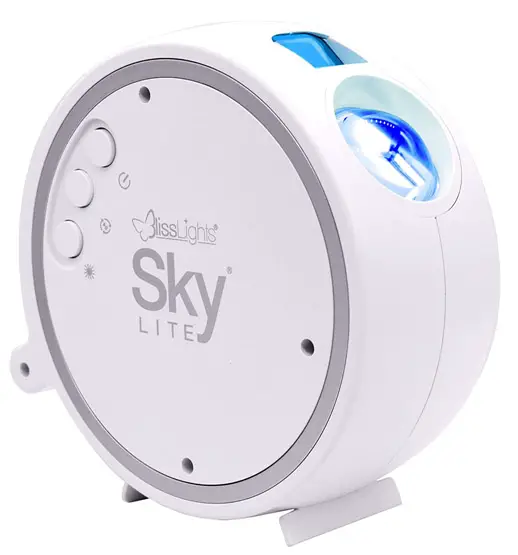
The projector comes with a 3-foot-long plug allowing you more flexibility of where you place it. Plus, the auto-off timer can be set up to 6 hours.
Pros:
- Easy to use.
- Long power lead
- 6-hour auto-off timer
- Lightweight and compact for easy storage
- Uses real laser diodes.
Cons:
- AC power only
- Not designed specifically for star gazing
Check the current price here
BlissLights Ark Lite
The Ark Lite incorporates a direct diode laser, precision glass optics and helographic technologies to create its otherworldly projection.

It’s simple button controls make it easy to use.
Pros:
- Affordable
- Easy to use.
- Vibrant colors
- 6-hour auto-off timer
Cons:
- Doesn’t have a remote
- Doesn’t mimic realistic view of the sky.
Check the current price here
The 8,000 Stars Home Planetarium by EastCoLeigh
With an inbuilt Bluetooth speaker, you can listen to your music or a space themed podcast while gazing at the stars. This projector also gives you the ability to see the night sky on different dates and the rotation features gives it the realistic feature.
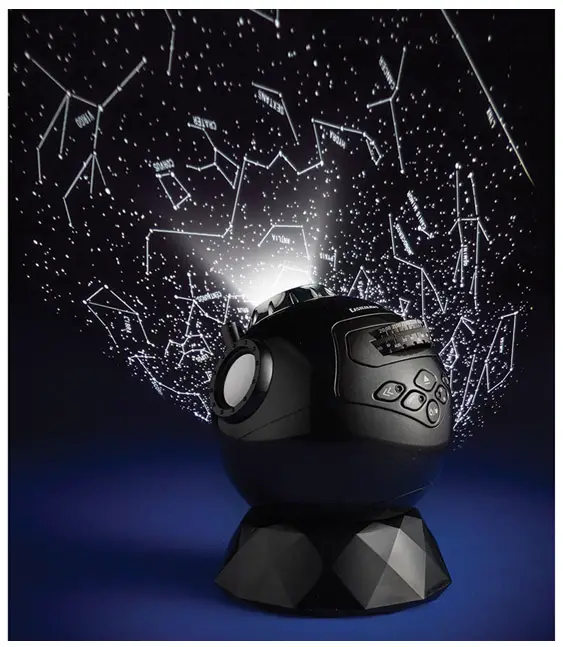
As the name suggests, it projects 8,000 stats and 61 constellations in the northern hemisphere accurately.
Pros:
- Bluetooth speakers
- Specific time/date display
- 5 speed rotation available
- Vivid and accurate display of stars
Cons:
- Powered by 3 AA batteries
Check the current price here
Riarmo Galaxy Star Projector
Let this projector show you a starry sky complete with 3 levels of brightness and an adjustable nebulae effect.
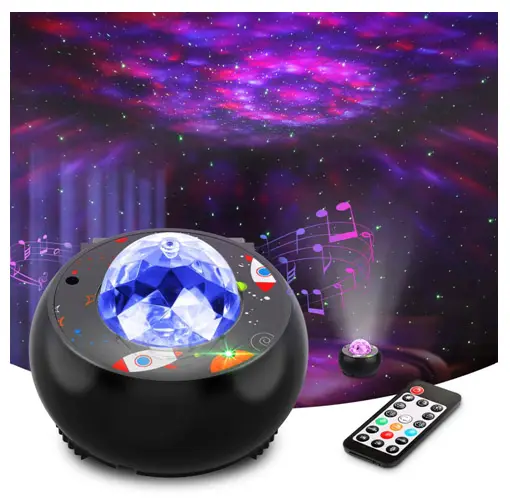
It also comes with a remote control and Bluetooth speaker with the ability to sync the lights to the music.
Pros:
- Affordable
- Brightness controls
- Remote included.
- 16 lighting effects
Cons:
- Doesn’t mimic realistic view of the night sky.
Check the current price here
Brainstorm Toys Deep Space Home Planetarium
The Deep Space Home Planetarium is a high-quality slide projector which includes 24 color NASA images across 3 interchangeable slide discs. Able to rotate with one of its 2 does projecting the stars and the other constellations.
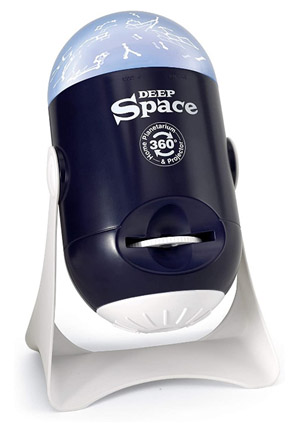
It also comes with a helpful educational booklet.
Pros:
- Easy to use.
- Affordable
- Multiple discs
Cons:
- Designed for kids.
- Not very detailed
Check the current price here
Laser Twilight Star Projector
Offers a realistic panorama of the night sky including comets, stars, and galaxies. It uses a mixture of blue and green stars that rotate and is capable of filling a large area.
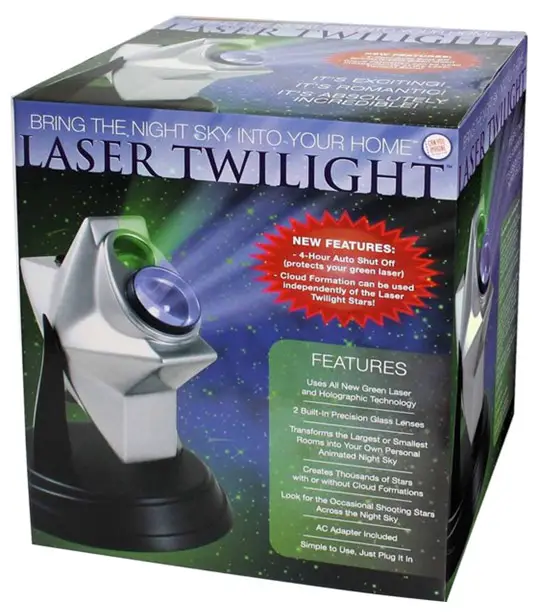
Powered by an AC adapter and the projector has a 4-hour auto-off feature.
Pros:
- Very simple to use.
- 1000+ stars and cloud formations
- 4-hour auto-off timer
- Fill up large area.
Cons:
- Only blue/green colors
Check the current price here
LBell 3 in 1 Galaxy Projector
This projector comes complete with remote control, auto-off timer, and Bluetooth speaker so you can listen to music as you study the stars.
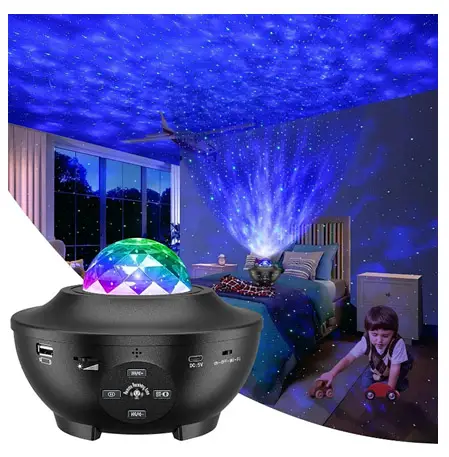
The projector has 16 million colors, 8 scene options and a 3-color flash mode.
Pros:
- Includes remote.
- USB cable and adapter
- Auto-off timer
Cons:
- Designed for mood lighting rather than realistic viewing of the stars.
- A little noisy
Check the current price here
Alternative Star Projectors
As technology has marched on, the ability to see and understand the night sky is becoming easier and easier. Now all you need is your phone and one of several free iOS or Android apps. Yes, there’s an app for that.
Here are Mike Smith’s essential apps for astrophotography.
If you are looking for star overlays have a look at fixthephoto.
Popular apps include iSky, Google Sky and Star Chart amongst others. Most star gazing apps have a free version which will allow you to point your phone up to the sky and identify what you are seeing.
So, when you are out with your camera taking photos of the night sky you have a map of the night sky in your pocket allowing you to easily identify or find the celestial object you are looking for!
Whether you are using a home planetarium or an app click here to find out how you can do astrophotography using DSLR and a telescope.









1 comment